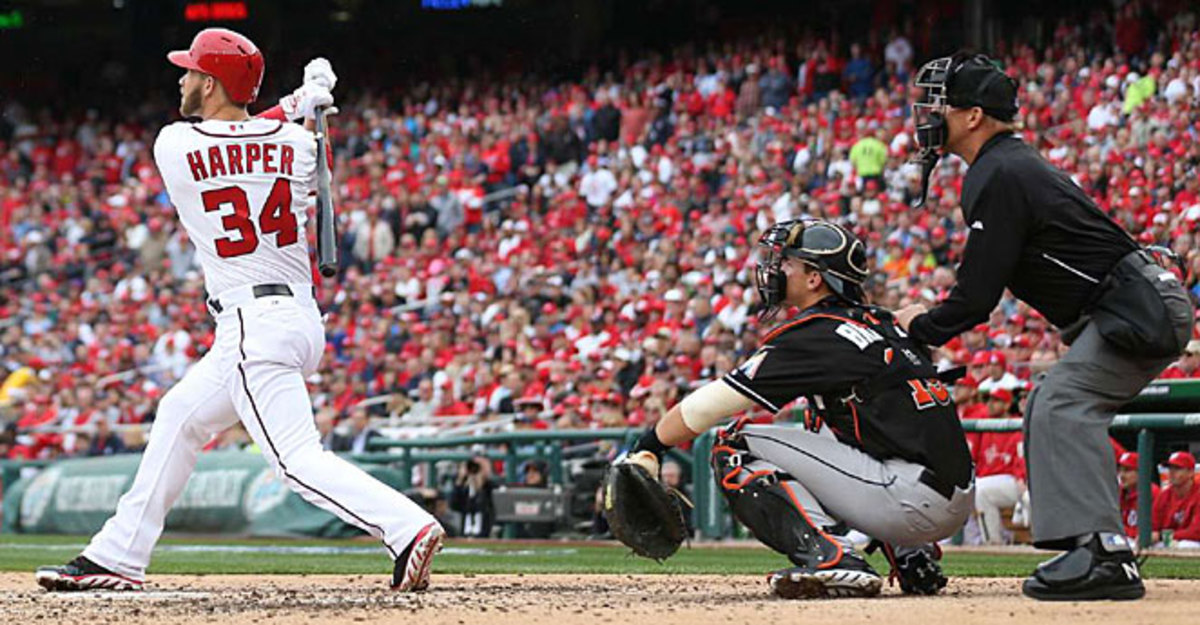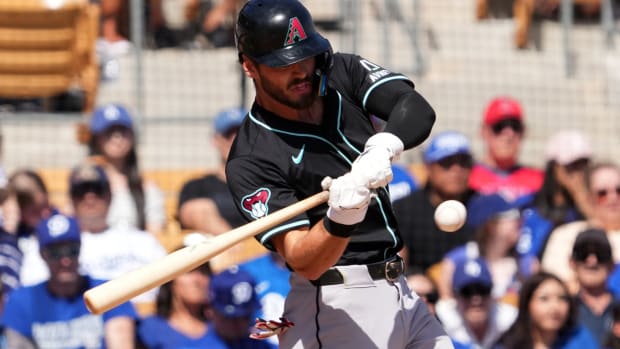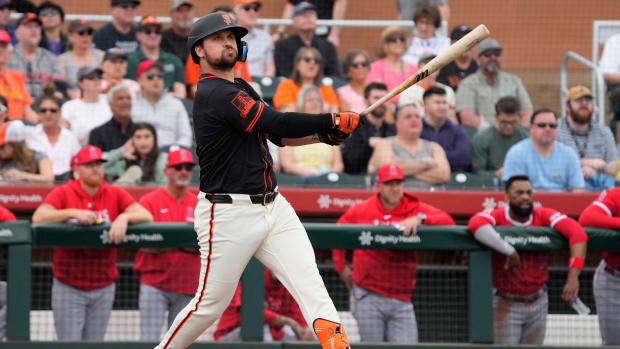The legend of Bryce Harper and more Opening Day lessons
Now that was one awesome Opening Day. Clayton Kershaw made the major leagues look like Little League, playing the role of the big 12-year-old kid who is the best pitcher and the best hitter. Bryce Harper carved out a piece of Opening Day history the way Bob Feller, Frank Robinson and Tuffy Rhodes did. And the first interleague Opening Day game in history didn't want to end.
Madness, I tell you. In one day baseball gave you more moments than the entire NCAA tournament did in two weeks. To put it all into perspective, here's some help: the 10 most important things we learned from Opening Day:
1. The legend of Bryce Harper grows
Sports Illustratedcover boy at 16. Number one pick at 17. Youngest position player All-Star at 19. And now, at 20, the youngest player to hit two home runs on Opening Day. Has any player been more comfortable in the spotlight?
It was impressive enough that Harper hit third in the Washington batting order on Opening Day at age 20 years and 196 days. Only five players were younger when they hit third on Opening Day: Ed Kranepool (1963 Mets), Mickey Mantle (1951 and 1952 Yankees), Gene Stephens (1953 Red Sox), Al Kaline (1955 Tigers) and the melodious sounding Beauty McGowan (1922 A's).
And yet that's not enough for Harper; he goes out there and hits a home run in the first swing of his first Opening Day (he began last year in the minors) and follows it with a home run in his next at-bat, too.
Harper is fast becoming the most compelling player to watch in baseball. He is so captivating and so good he may change how baseball is played. Follow me here: For the past decade or so the dominant hitting philosophy in the game has been a passive-aggressive approach in which the hitter takes pitches -- even in hitter's counts -- lets the ball get deep and uses a wide, balanced base. Think Joe Mauer, Albert Pujols and Joey Votto as the templates of this let-the-ball-travel, get-deep-into-counts and never-get-out-on-your-front-foot philosophy.
Now you have Harper just attacking pitches so fiercely and with such forward thrust that at contact for both home runs that his back foot was off the ground. He hits the ball out front and rarely lets pass a hittable pitch. It's an old school swing. Think Frank Thomas (only more aggressive), George Brett, Hank Aaron or Stan Musial -- great front-foot hitters. With so many people watching him, Harper has a chance to influence the next generation of hitters.
Let 'er rip.
2. We need more Bryce Harpers
Uh, have I mentioned that we are smack in the early stages of a great era of pitching -- especially young pitching?
Yes, I know it's only one day and it's a day when teams start their best pitcher. But geez, how was that for reminding us all that pitching rules the game? Here's some facts after the dozen games Monday:
? The three youngest of all 30 Opening Day starters -- Chris Sale, 24, Stephen Strasburg, 24, and Clayton Kershaw, 25 -- combined to throw 23 2/3 scoreless innings.
? Ten Opening Day starters have won so far. Here are their ages: 24, 25, 25, 26, 27, 28, 28, 28, 29, 30. Think of it this way: The oldest pitcher to win an Opening Day start this year has been Justin Verlander. He turned 30 in February.
? Kershaw joined Bob Lemon of the 1953 Indians as the only pitchers to throw a shutout and hit a home run on Opening Day. Folks, you only see days like this in Williamsport, not Dodger Stadium.
? The Angels became the first team ever to whiff 17 times on Opening Day and win.
? Nineteen of the 24 teams scored four runs or less. More than half the teams in baseball scored two runs or less, including five that scored nothing.
? The 12 games included an average of only 6.25 runs, as compared to the 2012 season average of 8.64.
? The 12 games included an average of 18.4 strikeouts, as compared to the 2012 season average of 15.0.
3. Stephen Strasburg will still be going strong in December at this rate
Operation Shutdown from 2012 is a thing of the past, especially with the efficiency in which Strasburg threw against Miami.
Until yesterday Strasburg was 0-5 with a 6.65 ERA in the 10 starts in his career in which he did not strike out at least five batters. But Strasburg, with a finely located fastball, found a new way to win. He struck out only three batters -- with no walks -- while throwing only 80 pitches in seven innings. He took care of 10 outs with groundballs.
Get this: Strasburg obtained a career-low two swings and misses and still put up seven scoreless innings. He barely broke a sweat before manager Davey Johnson pulled him. Seeing Strasburg win easily without having to run up a high pitch count or rely on strikeouts was just another positive sign for the best team in baseball.
4. Add CC Sabathia to the list of Yankees' worries
The disclaimer is important: it's only one game. But the way Sabathia threw Monday, on the heels of diminished stuff and an elbow cleanup last year, gives New York one more reason to be concerned about a slow start. He simply didn't show the usual arm speed and bite on his pitches, especially as he reached the fifth inning with a manageable number of pitches.
With two outs, manager Joe Girardi visited the mound to tell Sabathia to walk Johnny Gomes to get to lefthanded hitting rookie Jackie Bradley Jr. Sabathia was at 88 pitches. This was the best he could muster in a situation that called for the veteran to attack the rookie: 80 mph changeup for a ball, 88 mph fastball for a fouled strike, 89 mph fastball for a ball, 90 mph fastball for a ball, 90 mph fastball for a ball.
So it went most of the day for Sabathia, a guy whose average fastball last year dropped 1.5 mph to 92.3. You drop one mph off your fastball and the "Check Engine" light goes on; it's not to be taken lightly.
Now check out how his four-seam fastball of Opening Day 2013 compares to those from his four previous Opening Days with the Yankees:
The decline in velocity has been steady. Sabathia, by the way, was the fourth oldest Opening Day starter, trailing only the Blue Jays' R.A. Dickey, 38, the Braves' Tim Hudson, 37, and the Pirates' A.J. Burnett, 36.
On Monday Sabathia averaged only a six mph difference between his fastball and changeup (83 mph) -- not enough of a gap to be truly effective. After a spring in which the Yankees gave him only two of his starts in regulation major league "A" games (with 18 runners in 10 inning), Sabathia didn't show the kind of arm strength you would expect. Again: it's one start. But velocity three ticks below normal bears watching.
5. The depleted Yankees lineup was as lousy as it looked on paper
New York had just one extra base-hit when opening a season at home for the first time since 1992, a year that it ended with 86 losses. Of the 10 players who played in the 2012 opener for New York, only two played yesterday: Robinson Cano and Brett Gardner.
The other eight players from Opening Day 2012 are either hurt or no longer with the team: Derek Jeter, Nick Swisher, Alex Rodriguez, Mark Teixeira, Curtis Granderson, Andruw Jones, Raul Ibañez and Russell Martin. That's 178 home runs gone.
6. Somebody has to hit cleanup
Pedro Alvarez, Alfonso Soriano, Placido Polanco and Kevin Youkilis all hit fourth yesterday.
7. A.J. Burnett was the hard-luck loser of the day
Burnett struck out 10 batters on Opening Day and lost -- something that's been done only eight other times in history and not since Mike Mussina for the 1998 Orioles. The record for most strikeouts in an Opening Day loss is 12, by Tony Cloninger of the 1966 Braves, Gary Nolan of the 1969 Reds and Bob Gibson of the 1975 Cardinals.
8. Elvis Andrus is one lucky fellow
He's younger and a bit of a better defender than Erick Aybar, but I honestly don't see $85 million worth of difference between Andrus, 24, the Texas shortstop who will sign an eight-year, $120 million contract, and Aybar, 29, the Angels shortstop who a year ago signed a four-year, $35 million deal. Check out this comparison and see if you can find the $85 million difference:
9. Free agency is dead
Okay, we still have three quality lefthanded hitters on the market this fall: Robinson Cano, Jacoby Ellsbury and Shin-Soo Choo. But all of them will be in their 30s.
On the whole, there is so much money in the game that the best young stars are no longer getting on the market in their prime.
Andrus is just the latest young player to take long-term money rather than wait for free agency. Andrus, Justin Verlander, Felix Hernandez, Buster Posey, Evan Longoria, David Wright and Adam Wainwright all signed contracts since last season ended that will keep them with their one and only major league teams through at least the 2018 season.
And those signings come on the heels of Ryan Zimmerman, Andrew McCutchen, Starlin Castro, Joey Votto, Matt Kemp, Troy Tulowitzki, Cole Hamels and Ryan Braun -- again, all players who have played in the majors only with one club -- signing extensions with their teams that carry through 2018 or beyond.
Can we now please stop with the nostalgic nonsense that nobody stays with one team any more?
Maybe agent Scott Boras will give us Matt Wieters on the market in 2015 at age 29 or Harper in 2018 at age 25. But even Andrus, a Boras client, found the up-front money too good to pass up.
10. Baserunning is getting worse
Memo to major leaguers: Please stop making the third out of an inning on the bases to "make sure" the runner on second base scores on your hit.
Daniel Descalso was just the latest of many runners to make this trendy but foolish decision. With two outs in the seventh in Arizona, down 4-1, the Cardinals second baseman lined a single to centerfield to drive in Yadier Molina from second base. Molina, running with two outs, was scoring easily. St. Louis should have had the tying run coming to the plate.
Instead, even as the throw from centerfielder A.J. Pollack hit the cutoff man, Descalso kept running for second base -- apparently as part of that silly trend that by continuing to run you make sure the ball is cut off and the run will score. Descalso was thrown out. Inning over.
Molina didn't need any help. Descalso willingly gave up the last out of the inning unnecessarily -- preventing the tying run from coming to the plate, no less.
It happens way too often. Hey, guys, two words: please stop. And I really do mean stop. In this run-depressed environment, you can't be giving up outs on the bases unnecessarily.




































